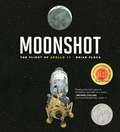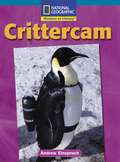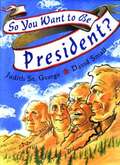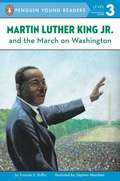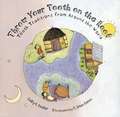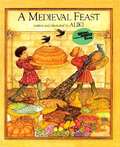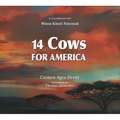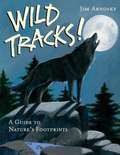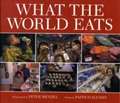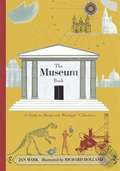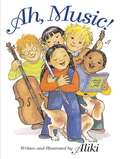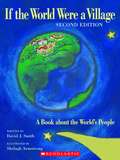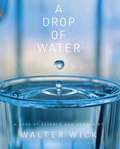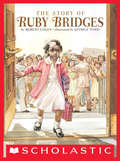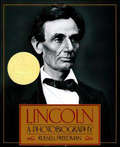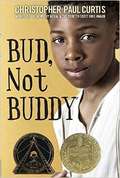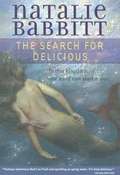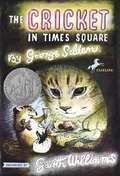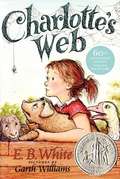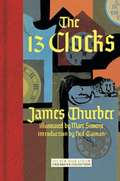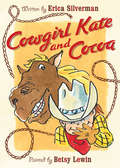Special Collections
Grade 2-3 Common Core Text Exemplars
Description: These books exemplify the level of complexity that Common Core State Standards require students to engage with. While the choices serve to help educators select texts of similar complexity, quality, and range, this not a required reading list. #teachers
- Table View
- List View
Where Do Polar Bears Live?
by Sarah L. ThomsonLet's-Read-and-Find-Out about Polar Bears. The Arctic might be a bit too chilly for you or me to live there, but it is the perfect home for polar bears. The fur between the pads of their paws keeps them from slipping on the ice. Their skin and blubber are like a warm blanket. But the earth is getting warmer and the ice is melting. Where will the polar bears live? How can we help protect their home? Read and find out!
[This text is listed as an example that meets Common Core Standards in English language arts in grades 2-3 at http://www.corestandards.org.]
Moonshot
by Brian Floca"We choose to go to the Moon.
We choose to go to the Moon in this decade and do the other things, not because they are easy, but because they are hard, because that goal will serve to organize and measure the best of our energies and skills, because that challenge is one that we are willing to accept, one we are unwilling to postpone, and one which we intend to win, and the others, too."
--John F. Kennedy, 1961
Simply told, grandly shown, here for a new generation of readers and explorers is the story of Apollo 11. Here are the steady astronauts, the ROAR of rockets, and the silence of the Moon. Here is a challenge met, a journey made, and a view of home, seen whole, from far away.
[This text is listed as an example that meets Common Core Standards in English language arts in grades 2-3 at http://www.corestandards.org.]
Winner of the Sibert Honor
Boy, Were We Wrong About Dinosaurs!
by Kathleen V. Kudlinski and S. D. SchindlerThe ancient Chinese thought dinosaurs were magical dragons. Some old-time scientists thought that because they were so big, all they could do was float in water. Boy, were they wrong! This lively book about the perennially popular subject of dinosaurs offers fascinating insight into how certain theories were formed, and then how those theories were proved or disproved. It demonstrates that scientific thought is as creative as it is logical and invites budding scientists to come up with their own ideas.
Crittercam
by Andrew EinspruchThis book is all about Crittercams and how these scientists use them to study everything the animal does.
So You Want to be President
by Judith St. George
That's a big job, and getting bigger But why not? Presidents have come in just about every variety They've been generals like George Washington and actors like Ronald Reagan; big like William Howard Taft, and small like James Madison; handsome like Franklin Pierce and homely like Abraham Lincoln; They've been born in log cabins like Andrew Jackson and mansions like William Harrison.
[This text is listed as an example that meets Common Core Standards in English language arts in grades 2-3 at http://www.corestandards.org.]
Winner of the 2000 Caldecott Medal
Martin Luther King Jr. and The March on Washington
by Frances E. RuffinOn August 28, 1963, more than 250,000 people came to the nation's capital. They came by plane, by bus, by car--even on roller-skates--to speak out against segregation and to demand equal rights for everyone. They also came to hear the words of a very special leader, Martin Luther King, Jr. Told with a wonderful immediacy, this book captures the spirit of this landmark day in American history and brings Dr. King's "I Have a Dream" speech to vivid life for young children.
Throw Your Tooth On The Roof
by Selby B. BeelerWhat do you do when you lose a tooth? Do you put it under your pillow and wait for the tooth fairy? Not if you live in Botswana! In Botswana, children throw their teeth onto the roof. In Afghanistan they drop their teeth down mouse holes, and in Egypt they fling their teeth at the sun! Travel around the world and discover the surprising things children do when they lose a tooth.
Selby B. Beeler spent years collecting traditions from every corner of the globe for this whimsical book, and illustrator G. Brian Karas adds to the fun, filling every page with humorous detail. He perfectly captures the excitement and pride that children experience when a tooth falls out.
This title has been selected as a Common Core Text Exemplar (Grades 2-3, Informational Texts)
From Seed to Plant
by Gail GibbonsExplores the intricate relationship between seeds and the plants which they produce. [This text is listed as an example that meets Common Core Standards in English language arts in grades 2-3 at http://www.corestandards.org.]
A Medieval Feast
by AlikiDescribes the preparation and celebration of a medieval feast held at an English manor house entertaining royal guests.
[This text is listed as an example that meets Common Core Standards in English language arts in grades 2-3 at http://www.corestandards.org.]
14 Cows for America
by Carmen Agra Deedy and Wilson Kimeli NaiyomahIt is June of 2002, and a very unusual ceremony begins in a far-flung village in western Kenya.
An American diplomat is surrounded by hundreds of Maasai people. A gift is about to be bestowed on the men, women, and children of America, and he is there to accept it. The gift is as unsought and unexpected as it is extraordinary.
A mere nine months have passed since the September 11 attacks, and hearts are raw. Tears flow freely from American and Maasai alike as these legendary warriors offer their gift to a grieving people half a world away.
World of the gift will travel news wires around the globe. Many will be profoundly touched, but for Americans, this selfless gesture will have deeper meaning still.
For a heartsick nation, the gift of fourteen cows emerges from the choking dust and darkness as a soft light of hope ... and friendship.
[This text is listed as an example that meets Common Core Standards in English language arts in grades 2-3 at http://www.corestandards.org.]
Wild Tracks!
by Jim ArnoskyWhen children learn to recognize and read animal tracks they're actually mastering an ancient language of shapes and patterns--and gaining knowledge of the natural world.
This is the perfect gift for a budding naturalist, animal lover, or artist. Jim Arnosky has been honored for his overall contribution to literature for children by the Eva L. Gordon Award and the Washington Post/Children's Book Guild Award for nonfiction. Many of his books have been chosen as ALA Notable Books, including Drawing from Nature, a Christopher Award-winner. Wild Tracks! is Jim's 100th book for children. Image descriptions present.
What the World Eats
by Faith D'Aluisio and Peter MenzelSitting down to a daily family meal has long been a tradition for billions of people. But in every corner of the world this age-old custom is rapidly changing. From increased trade between countries to the expansion of global food corporations like Kraft and Nestle, current events are having a tremendous impact on our eating habits. Chances are your supermarket is stocking a variety of international foods, and American fast food chains like McDonald's and Kentucky Fried Chicken are popping up all over the planet. For the first time in history, more people are overfed than underfed. And while some people still have barely enough to eat, others overeat to the point of illness.
To find out how mealtime is changing in real homes, authors Peter Menzel and Faith D'Aluisio visited families around the world to observe and photograph what they eat during the course of one week. They joined parents while they shopped at mega grocery stores and outdoor markets, and participated in a feast where a single goat was shared among many families. They watched moms making dinner in kitchens and over cooking fires, and they sat down to eat with twenty-five families in twenty-one countries--if you're keeping track, that's about 525 meals!
The foods dished up ranged from hunted seal and spit-roasted guinea pig to U. N. -rationed grains and gallons of Coca-Cola. As Peter and Faith ate and talked with families, they learned firsthand about food consumption around the world and its corresponding causes and effects. The resulting family portraits offer a fascinating glimpse into the cultural similarities and differences served on dinner plates around the globe.
[This text is listed as an example that meets Common Core Standards in English language arts in grades 2-3 at http://www.corestandards.org.]
The Museum Book
by Jan MarkJan Mark takes readers through museums' multifaceted history. Numerous questions answer in the books are: What is a museum? Why would anyone amass shells, words, clocks, teeth, trains, dinosaurs, mummies...or two-headed sheep? Find out where the word "museum" comes from and what unusual items (unicorn horns? mermaids?) some early museums placed on view.
[This text is listed as an example that meets Common Core Standards in English language arts in grades 2-3 at http://www.corestandards.org.]
Ah, Music!
by AlikiSurveys the history and components of music, concentrating on Western musical traditions.
[This text is listed as an example that meets Common Core Standards in English language arts in grades 2-3 at http://www.corestandards.org.]
If the World Were a Village
by David J. Smith.This is the new paperback edition of a beautiful and unique book, which explains facts about the world's population in a simple and fascinating way. Instead of unimaginable billions, it presents the whole world as a village of just 100 people. We soon find out that 22 speak a Chinese dialect and that 17 cannot read or write. We also discover the people's religions, their education, their standard of living, and much much more...This book provokes thought and elicits questions. It cannot fail to inspire children's interest in world geography, citizenship and different customs and cultures, whether they read it at home or at school.
A Drop of Water
by Walter WickThe most spectacular photographs ever created on the subject of water appear in this unique science book by Walter Wick. The camera stops the action and magnifies it so that all the amazing states of water can be observed - water as ice, rainbow, stream, frost, dew. Readers can examine a drop of water as it falls from a faucet, see a drop of water as it splashes on a hard surface, count the points of an actual snowflake, and contemplate how drops of water form clouds.
[This text is listed as an example that meets Common Core Standards in English language arts in grades 2-3 at http://www.corestandards.org.]
The Story of Ruby Bridges
by Robert ColesThe inspirational true story of Ruby Bridges.The year is 1960, and six-year-old Ruby Bridges and her family have recently moved from Mississippi to New Orleans in search of a better life. When a judge orders Ruby to attend first grade at William Frantz Elementary, an all-white school, Ruby must face angry mobs of parents who refuse to send their children to school with her. Told with Robert Coles' powerful narrative and dramatically illustrated by George Ford, Ruby's story of courage, faith, and hope continues to resonate more than 60 years later.
Lincoln
by Russell FreedmanThe Newbery Medal–winning book for young readers presents &“a human portrait of a politician honorably confronting the most vexing issues of his era&” (The New York Times Book Review). Abraham Lincoln stood out in a crowd as much for his wit and rollicking humor as for his height. This Newbery Medal-winning biography of our Civil War president is warm, appealing, and illustrated with dozens of carefully chosen photographs and prints. Russell Freedman begins with a lively account of Abraham Lincoln's boyhood, his career as a country lawyer, and his courtship and marriage to Mary Todd. Then the author focuses on Lincoln&’s presidency, skillfully explaining the many complex issues he grappled with as he led a deeply divided nation through the Civil War. The book's final chapter is a moving account of his tragic death at Ford's Theatre on April 14, 1865. The volume concludes with a sampling of Lincoln writings and a detailed list of Lincoln historical sites. "Few, if any, of the many books written for children about Lincoln can compare with Freedman's contribution…This is an outstanding example of what (juvenile) biography can be. Like Lincoln himself, it stands head and shoulders above its competition." —School Library Journal
The Sign Painter
by Allen SayIn his Caldecott acceptance speech for GRANDFATHER'S JOURNEY, Allen Say told of his difficulty in separating his dreams from reality. For him this separation was not as important as finding a meaning behind the contradictions and choices we all must make in life and their consequences.
Early one morning a boy comes into town, hungry, and looking for work. He meets a sign painter who takes him on as a helper. The boy yearns to be a painter. The man offers him security. The two are commissioned to paint a series of billboards in the desert. Each billboard has one word, Arrowstar. They do not know its meaning. As they are about to paint the last sign, the boy looks up and sees in the distance a magnificent structure. Is it real? They go to find out.
Through a simple text and extraordinary paintings, the reader learns of the temptation of safe choices and the uncertainties of following a personal dream. Here Allen Say tells a haunting and provocative story of dreams and choices for readers of all ages.
[This text is listed as an example that meets Common Core Standards in English language arts in grades 2-3 at http://www.corestandards.org.]
Bud, Not Buddy
by Christopher Paul Curtis"It's funny how ideas are, in a lot of ways they're just like seeds. Both of them start real, real small and then... woop, zoop, sloop... before you can say Jack Robinson, they've gone and grown a lot bigger than you ever thought they could."
So figures scrappy 10-year-old philosopher Bud--"not Buddy"--Caldwell, an orphan on the run from abusive foster homes and Hoovervilles in 1930s Michigan. And the idea that's planted itself in his head is that Herman E. Calloway, standup-bass player for the Dusky Devastators of the Depression, is his father. Guided only by a flier for one of Calloway's shows--a small, blue poster that had mysteriously upset his mother shortly before she died--Bud sets off to track down his supposed dad, a man he's never laid eyes on. And, being 10, Bud-not-Buddy gets into all sorts of trouble along the way, barely escaping a monster-infested woodshed, stealing a vampire's car, and even getting tricked into "busting slob with a real live girl."
Christopher Paul Curtis, author of The Watsons Go to Birmingham--1963, once again exhibits his skill for capturing the language and feel of an era and creates an authentic, touching, often hilarious voice in little Bud.
Newbery Medal Winner and Winner of the Coretta Scott King Medal
Winner of Pacific Northwest Library Association’s Young Reader’s Choice Junior Award
The Search for Delicious
by Natalie BabbittGaylen, the King's messenger, a skinny boy of twelve, is off to poll the kingdom, traveling from town to farmstead to town on his horse, Marrow. At first it is merely a question of disagreement at the royal castle over which food should stand for Delicious in the new dictionary. But soon it seems that the "Search for Delicious" had better succeed if civil war is to be avoided.
Gaylen's quest leads him to the woldweller, a wise, 900-year-old creature who lives alone at the precise center of the forest; to Canto, the minstrel who sings him an old song about a mermaid child and who gives him a peculiar good-luck charm; to the underground domain of the dwarfs; and finally to Ardis who might save the kingdom from havoc.
[This text is listed as an example that meets Common Core Standards in English language arts in grades 2-3 at http://www.corestandards.org.]
The Cricket in Times Square
by George SeldenAfter Chester, a cricket, arrives in the Times Square subway station, he takes up residence in a newsstand. Between escapades in New York City, Chester and four new friends manage to bring success to the almost bankrupt newsstand.
Newbery Medal honors book
Charlotte's Web
by E. B. WhiteThis beloved book by E. B. White, author of Stuart Little and The Trumpet of the Swan, is a classic of children's literature that is "just about perfect." Some Pig. Humble. Radiant. These are the words in Charlotte's Web, high up in Zuckerman's barn.
Charlotte's spiderweb tells of her feelings for a little pig named Wilbur, who simply wants a friend. They also express the love of a girl named Fern, who saved Wilbur's life when he was born the runt of his litter. E. B. White's Newbery Honor Book is a tender novel of friendship, love, life, and death that will continue to be enjoyed by generations to come.
This book supports the Common Core State Standards Includes image descriptions. Image descriptions present.
The Thirteen Clocks
by James ThurberIn a cold gloomy castle where all the clocks have stopped, a wicked Duke amuses himself by finding new and fiendish ways of rejecting the suitors for his niece, the good and beautiful Princess Saralinda. Includes descriptions of illustrations.
[This text is listed as an example that meets Common Core Standards in English language arts in grades 2-3 at http://www.corestandards.org.]
Cowgirl Kate and Cocoa
by Erica Silverman and Betsy LewinA Theodor Seuss Geisel Award Honor Book Hold on to your hats! Two new pals have arrived on the scene: Cowgirl Kate and her stubborn, but devoted cowhorse, Cocoa. Together they count the herd, ride the range, and, of course, argue till the cows come home--as only best friends can do.With its spirited text and bright, humorous illustrations by Caldecott Honor recipient Betsy Lewin, this first book in the Cowgirl Kate and Cocoa series is bound to be a hit with young wranglers everywhere. This title has been selected as a Common Core Text Exemplar (Grades 2-3, Stories)

